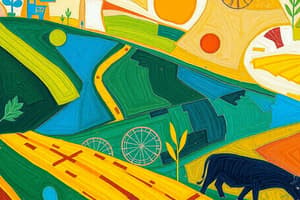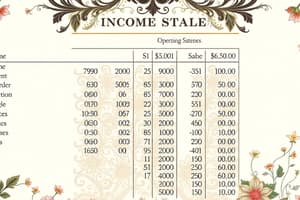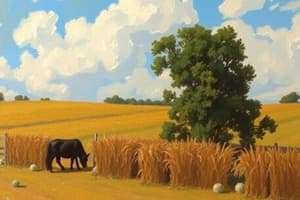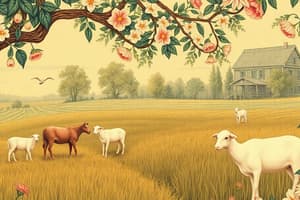Podcast
Questions and Answers
Between 1983-84 and 2011-12, how did the rate of increase in agricultural output compare to the increase in input costs and wages?
Between 1983-84 and 2011-12, how did the rate of increase in agricultural output compare to the increase in input costs and wages?
Agricultural output increased more than input costs, but less than wages.
What were the three possible reasons given for explaining the increase in the wage bill between 1983-84 and 2011-12? Which reason was identified as the primary driver?
What were the three possible reasons given for explaining the increase in the wage bill between 1983-84 and 2011-12? Which reason was identified as the primary driver?
Possible reasons: increase in laborers, increase in daily wage, and increase in employment days. The primary driver was the increase in wage rate.
How did nominal farm income change between 1983-84 and 2011-12, and approximately what was the corresponding increase in the CPIAL?
How did nominal farm income change between 1983-84 and 2011-12, and approximately what was the corresponding increase in the CPIAL?
Nominal farm income multiplied 20 times, while the CPIAL increased 6.9 times.
Explain how real farm income is calculated and describe the overall trend in real farm income from 1983-84 to 2011-12.
Explain how real farm income is calculated and describe the overall trend in real farm income from 1983-84 to 2011-12.
Describe the trend of real farm income in the periods 1983-84 to 1993-94 and 1993-94 to 2011-12.
Describe the trend of real farm income in the periods 1983-84 to 1993-94 and 1993-94 to 2011-12.
Explain why the year 2009-10 was excluded from the farm income data analysis, and what year was used as a substitute?
Explain why the year 2009-10 was excluded from the farm income data analysis, and what year was used as a substitute?
Between 1983-84 and 2011-12, how did the total cost of agricultural production increase when labor costs were included, and what does this suggest about the significance of labor in agricultural economics?
Between 1983-84 and 2011-12, how did the total cost of agricultural production increase when labor costs were included, and what does this suggest about the significance of labor in agricultural economics?
Calculate the approximate real increase in farm income between 1993-94 and 2011-12, using the values provided. Express your answer in Rupees.
Calculate the approximate real increase in farm income between 1993-94 and 2011-12, using the values provided. Express your answer in Rupees.
Describe the general trend of agriculture's contribution to India's GDP and what factors contribute to fluctuations in agricultural growth?
Describe the general trend of agriculture's contribution to India's GDP and what factors contribute to fluctuations in agricultural growth?
What was the range of annual growth rates in farm income per cultivator from 1983-84 to 2011-12, and during which period was the growth most significant?
What was the range of annual growth rates in farm income per cultivator from 1983-84 to 2011-12, and during which period was the growth most significant?
Outline the distribution ratio between cultivators and laborers in the total income of the agricultural sector based on recent data.
Outline the distribution ratio between cultivators and laborers in the total income of the agricultural sector based on recent data.
How did the share of farm income relative to the net value added of agriculture change from 1983-84 to 1999-2000, and what followed this period?
How did the share of farm income relative to the net value added of agriculture change from 1983-84 to 1999-2000, and what followed this period?
What is the significance of the Green Revolution technologies in the context of Indian agricultural growth?
What is the significance of the Green Revolution technologies in the context of Indian agricultural growth?
Based on the data provided, describe the trend in the number of agricultural laborers from 1983-84 to 2011-12 and what might be the reason for this trend?
Based on the data provided, describe the trend in the number of agricultural laborers from 1983-84 to 2011-12 and what might be the reason for this trend?
Explain how Net Value Added is calculated and propose a reason for its growth from 67,482 Rs crore in 1983-84 to 13,97,167 Rs crore in 2011-12.
Explain how Net Value Added is calculated and propose a reason for its growth from 67,482 Rs crore in 1983-84 to 13,97,167 Rs crore in 2011-12.
What implications can you deduce from the increase in wage earnings per labor per day from Rs 6.2 in 1983-84 to Rs 121.4 in 2011-12?
What implications can you deduce from the increase in wage earnings per labor per day from Rs 6.2 in 1983-84 to Rs 121.4 in 2011-12?
Identify a potential challenge in comparing the 'Farm Income' across the given years without additional data. What additional economic indicator would improve the comparison?
Identify a potential challenge in comparing the 'Farm Income' across the given years without additional data. What additional economic indicator would improve the comparison?
Describe how an increase in 'Input' costs might affect 'Farm Income', assuming all other variables remain constant.
Describe how an increase in 'Input' costs might affect 'Farm Income', assuming all other variables remain constant.
Explain the relationship between 'Agricultural Labour', 'Wage Bill' and 'Wage Earning', using data from any two years from the table, and how changes in these variables might reflect shifts in agricultural practices or policies?
Explain the relationship between 'Agricultural Labour', 'Wage Bill' and 'Wage Earning', using data from any two years from the table, and how changes in these variables might reflect shifts in agricultural practices or policies?
Based on the data, what conclusions can you draw about the productivity of cultivators (land owners) versus agricultural laborers between 1983-84 and 2011-12?
Based on the data, what conclusions can you draw about the productivity of cultivators (land owners) versus agricultural laborers between 1983-84 and 2011-12?
How might changes in the number of days of wage employment (not explicitly provided but used to compute the table) impact the reported 'Wage Bill', and what external factors might influence these changes?
How might changes in the number of days of wage employment (not explicitly provided but used to compute the table) impact the reported 'Wage Bill', and what external factors might influence these changes?
Based on Table 2, describe the trend in farm income at current prices from 1983-84 to 2011-12. What general statement can you make about the overall trend?
Based on Table 2, describe the trend in farm income at current prices from 1983-84 to 2011-12. What general statement can you make about the overall trend?
Explain how the Consumer Price Index of Agricultural Labour (CPIAL) is used to derive the 'Farm Income Deflated by CPIAL' values in Table 2. Why is this deflation important for economic analysis?
Explain how the Consumer Price Index of Agricultural Labour (CPIAL) is used to derive the 'Farm Income Deflated by CPIAL' values in Table 2. Why is this deflation important for economic analysis?
What factors contributed to the increase in the share of wages paid to hired labor between 1983-84 and 1999-2000?
What factors contributed to the increase in the share of wages paid to hired labor between 1983-84 and 1999-2000?
Explain why the share of wages in output declined by 20% between 1999-2000 and 2004-05, despite only a small decline in the number of agricultural laborers, according to the text.
Explain why the share of wages in output declined by 20% between 1999-2000 and 2004-05, despite only a small decline in the number of agricultural laborers, according to the text.
How did the trend in the share of wages in agricultural output change after 2004-05, and what does the text suggest as the reason for this change?
How did the trend in the share of wages in agricultural output change after 2004-05, and what does the text suggest as the reason for this change?
Based on the information provided, what was the percentage of agricultural output value allocated to input costs (seeds, fertilizer, etc.) in the years 1993-94 and 1999-2000.?
Based on the information provided, what was the percentage of agricultural output value allocated to input costs (seeds, fertilizer, etc.) in the years 1993-94 and 1999-2000.?
How did the distribution of agricultural output change with respect to input costs between the periods of 1983-88 and 2011-12?
How did the distribution of agricultural output change with respect to input costs between the periods of 1983-88 and 2011-12?
The text describes an 'opposite effect' of labor shifts on wage rates. Explain this effect, noting the different time periods when different shifts occur.
The text describes an 'opposite effect' of labor shifts on wage rates. Explain this effect, noting the different time periods when different shifts occur.
Based on the information provided, describe the trend in the annual growth rate of real total farm income between the periods 1983-84 to 2004-05 and 2004-05 to 2011-12. What factors contributed to the growth in per cultivator income after 2004-05?
Based on the information provided, describe the trend in the annual growth rate of real total farm income between the periods 1983-84 to 2004-05 and 2004-05 to 2011-12. What factors contributed to the growth in per cultivator income after 2004-05?
How did the growth in real income per hectare of net sown area (NSA) compare with the growth in real income per cultivator between 1999-2000 and 2011-12? What does this suggest about the efficiency of land use during this period?
How did the growth in real income per hectare of net sown area (NSA) compare with the growth in real income per cultivator between 1999-2000 and 2011-12? What does this suggest about the efficiency of land use during this period?
In 2011-12, how did the real income per holding compare to the real income per cultivator? Provide a possible reason for this difference.
In 2011-12, how did the real income per holding compare to the real income per cultivator? Provide a possible reason for this difference.
Describe the relationship between real farm income and wage earnings for agricultural laborers between 1983-84 and 2011-12. What might explain the differences or similarities in their growth trends?
Describe the relationship between real farm income and wage earnings for agricultural laborers between 1983-84 and 2011-12. What might explain the differences or similarities in their growth trends?
Calculate the approximate percentage increase in real income per cultivator from farming between 2004-05 and 2011-12. Show your work.
Calculate the approximate percentage increase in real income per cultivator from farming between 2004-05 and 2011-12. Show your work.
Based on Table 7, describe the trend in the ratio of wage earnings of an agricultural laborer to the income of a farmer from 1983-84 to 2011-12. What does this trend suggest about the economic condition of agricultural laborers relative to farmers?
Based on Table 7, describe the trend in the ratio of wage earnings of an agricultural laborer to the income of a farmer from 1983-84 to 2011-12. What does this trend suggest about the economic condition of agricultural laborers relative to farmers?
Referring to Table 7, analyze the changes in the ratio of non-agricultural worker income to farm income (N:F) between 1983-84 and 2004-05. What does this trend indicate about the comparative economic growth in non-agricultural versus agricultural sectors during this period?
Referring to Table 7, analyze the changes in the ratio of non-agricultural worker income to farm income (N:F) between 1983-84 and 2004-05. What does this trend indicate about the comparative economic growth in non-agricultural versus agricultural sectors during this period?
What percentage above the poverty line is the average income of a farmer household dependent on agriculture? What does this imply about the economic vulnerability of farmers?
What percentage above the poverty line is the average income of a farmer household dependent on agriculture? What does this imply about the economic vulnerability of farmers?
Based on the information provided, what is the estimated landholding size below which a farmer's household is likely to fall into poverty, assuming they have no other sources of income?
Based on the information provided, what is the estimated landholding size below which a farmer's household is likely to fall into poverty, assuming they have no other sources of income?
The text mentions unseasonal rains in March and April 2015, following an adverse monsoon in 2014. Explain how these weather events collectively impacted agricultural output and farmers' livelihoods.
The text mentions unseasonal rains in March and April 2015, following an adverse monsoon in 2014. Explain how these weather events collectively impacted agricultural output and farmers' livelihoods.
About what percentage of farm households in India would be living in poverty if they did not have earnings from non-farm sources?
About what percentage of farm households in India would be living in poverty if they did not have earnings from non-farm sources?
What is the estimated average farm income per farm household, according to the text? How does this figure compare to the poverty line for a family of five members in rural areas?
What is the estimated average farm income per farm household, according to the text? How does this figure compare to the poverty line for a family of five members in rural areas?
The provided information suggests a disparity between farm and non-farm income. Briefly discuss a potential consequence of this disparity on the agricultural sector.
The provided information suggests a disparity between farm and non-farm income. Briefly discuss a potential consequence of this disparity on the agricultural sector.
Flashcards
Nominal Output
Nominal Output
Total value of agricultural outputs, such as crops and livestock, at current prices.
Wage Bill
Wage Bill
Total earnings paid to agricultural laborers for their work.
Input Costs
Input Costs
The expenses incurred in agricultural production (seeds, fertilizers).
Net Value Added
Net Value Added
Signup and view all the flashcards
Wage Earning (per day)
Wage Earning (per day)
Signup and view all the flashcards
Farm Income
Farm Income
Signup and view all the flashcards
Agricultural Labour
Agricultural Labour
Signup and view all the flashcards
Cultivators
Cultivators
Signup and view all the flashcards
NSSO Quinquennium Surveys
NSSO Quinquennium Surveys
Signup and view all the flashcards
Cost of Inputs
Cost of Inputs
Signup and view all the flashcards
Wage Bill Increase (1984-2012)
Wage Bill Increase (1984-2012)
Signup and view all the flashcards
Real Farm Income Increase
Real Farm Income Increase
Signup and view all the flashcards
CPIAL
CPIAL
Signup and view all the flashcards
Farm Income Growth
Farm Income Growth
Signup and view all the flashcards
2011-12 Farm Income
2011-12 Farm Income
Signup and view all the flashcards
Income per Hectare (2011-12)
Income per Hectare (2011-12)
Signup and view all the flashcards
Real Farm Income
Real Farm Income
Signup and view all the flashcards
Farm Income Growth (1983-94)
Farm Income Growth (1983-94)
Signup and view all the flashcards
Post-2004 Farm Income Growth
Post-2004 Farm Income Growth
Signup and view all the flashcards
Deflated Farm Income
Deflated Farm Income
Signup and view all the flashcards
Agricultural Input Costs
Agricultural Input Costs
Signup and view all the flashcards
Wage Share in Agriculture
Wage Share in Agriculture
Signup and view all the flashcards
Days of Wage Employment
Days of Wage Employment
Signup and view all the flashcards
Decline in Input Cost Share
Decline in Input Cost Share
Signup and view all the flashcards
Increase in Wage Share Post-2005
Increase in Wage Share Post-2005
Signup and view all the flashcards
2004-05 Profit Rate
2004-05 Profit Rate
Signup and view all the flashcards
Cultivator Income Growth (2004-2012)
Cultivator Income Growth (2004-2012)
Signup and view all the flashcards
Income Distribution Ratio
Income Distribution Ratio
Signup and view all the flashcards
Agriculture's GDP Share
Agriculture's GDP Share
Signup and view all the flashcards
Agricultural Growth Variability
Agricultural Growth Variability
Signup and view all the flashcards
Farm Income Per Cultivator
Farm Income Per Cultivator
Signup and view all the flashcards
Wage Earning (Agricultural Laborer)
Wage Earning (Agricultural Laborer)
Signup and view all the flashcards
Income (Non-agriculture Worker)
Income (Non-agriculture Worker)
Signup and view all the flashcards
Ratio L:F
Ratio L:F
Signup and view all the flashcards
Ratio N:F
Ratio N:F
Signup and view all the flashcards
Poverty Line
Poverty Line
Signup and view all the flashcards
Agrarian Distress
Agrarian Distress
Signup and view all the flashcards
Impact of Poor Monsoon
Impact of Poor Monsoon
Signup and view all the flashcards
Study Notes
- A study estimates farmers' incomes from agriculture over the past three decades.
- Farmers' income from agricultural activities, after paying for costs and wages for hired labor, experienced varied growth rates across different periods.
- There was no period of squeezed income or profitability for the farmers' farming.
- Reduction in disparity growth between farmers and non-farmers began around 2004-05 but was unsustainable after 2011-12.
- Farm income growth after 2011-12 plummeted to around 1%, contributing to the recent agrarian distress.
Background on Farm Income
- Farm income is the most appropriate measure of farmers' well-being.
- Appropriate farm income estimates are lacking in most countries, including India.
- Conclusions are drawn by alluding to policies, indicators that directly or indirectly affect agriculture, and proxies for farmers' income given the absence of actual estimates.
- Some scholars observe a policy bias against the sector, while others allege markets are biased against agriculture.
- Primary commodities rise slower than the manufacturing sector prices.
- Numerous studies examine this phenomenon using terms of trade between agriculture and other sectors.
- Some studies reveal that the terms of trade remain against agriculture, while others find them in its favor.
- The main reason behind it is the choice of study period.
- Since 1950-51, the terms of trade for agriculture showed no trend while fluctuating considerably over time.
- Discrimination against agriculture manifests in the disparity in per-worker income between the agricultural and non-agricultural sectors.
- The non-agriculture sector saw a faster rise in per worker income than agriculture.
- Higher decline in agriculture's share in national income, compared to the decline in the share of agricultural workforce, is the reason behind this.
- There is a conclusion from some studies that farm income is low and stagnant, contributing to agrarian distress and farmers abandoning farming.
- There is an absence of information about farm income, indicators like the value of agricultural output, and net domestic product (NDP) of the sector is used.
Alternative Estimates of Farm Income
- Various sources were used to draw inferences about farm income, including sector income from selected crops and survey-based estimates.
- These estimates and indicators are proxies, and are not truly representative of farm income in India.
- Some scholars have attempted to prepare estimates of farm income based on a sample of farmers or a segment of agriculture.
- One study estimated the annual net income of a farmer household to be low, i.e., Rs 2,837 in 2002-03.
- Deduction of costs occurred twice making the reported income one-fourth of the actual income.
- It only included crop income, and ignored income from livestock.
- The estimate increased to Rs 12,720 when income from livestock was added.
- Another estimate put the per hectare farm income for the country at Rs 33,267 per hectare during 2007-09.
- This shows 62% of farmers in India earn less than the poverty line during 2007-09.
- Farm business income was estimated using data from the central government's Comprehensive Scheme for Studying the Cost of Cultivation between 1981-82 to 1999-2000.
- It suffers the shortcomings and limitations of only covering crop complexes in major growing states, and excluding horticultural crops, and several minor crops.
- Farm business income from Cost of Cultivation (COC) data does not adequately measure actual farm business income due to limitations.
- This can be used as indicators of crops that are selected at best.
- Surprisingly, official agencies in the country do not prepare or publish estimates of farm income.
- Most surprisingly, no study has estimated farm income at the national and state levels.
- In reality, crucial information such as higher input prices, slow output growth, rising wages, increasing indebtedness, and the rising gap between farm harvest and retail prices is used as evidence to prove a decline in farm income.
- Research constructs a proper farm income series, from covering three decades, beginning 1983 and ending in 2011–12.
Estimation Procedure
- It can be taken as a measure of income accruing to farmers from agricultural production.
- Sectoral income (net value added or NDP) of agriculture income is not allocated to farmers alone.
- Income of the sector is shared by hired farm labor, and farmers.
- It is not the same as income of the sector with a wage bill in cash or in kind to labor hired for farm work.
- Changes in the workforce composition and the total production cost change the ratio of farm income to sectoral income.
- Changes in real wages can also be brought.
- Differences between farm income and agricultural income and their different paths occur due to underlying reasons.
- Value added in agriculture or NDP from this does not represent farm income.
- Farm income was derived from gross domestic product (GDP)
- Agriculture and allied =GDP agriculture and allied sectors, less capital consumption, minus wage
- Wage bill for hired labor = NDP agriculture and allied sectors less wage bill for hired laboEqn (1)
Computing the Wage Bill for the Agriculture (agriculture and allied) sector
- Wage bill was computed based on several underlying factors.
- Factors are the number of hired laborers employed in agriculture with per day agricultural wage earnings, and the number of days of wage employment in a year.
- Data from the published reports and unit record data at the household level in various rounds of the National Sample Survey Office (NSSO) on employment and underemployment.
- The hired labor consisted of casual plus regular labor in agriculture and allied operations in the usual status.
- The data for 2011-12 was derived using interpolation methods.
Preparation of the Estimates of Farm Income
- The estimates of farm income are corresponding to six rounds of the NSSO on employment: 1983, 1987-88, 1993-94, 1999-2000, 2004-05, 2011-12.
- To arrive at real farm income, farm income obtained at current prices from equation (1) was deflated by the Consumer Price Index for Agricultural Laborers (CPIAL).
- CPIAL data was obtained from the website of the Reserve Bank of India and the office of the economic adviser.
- Per cultivator, per land-holding, and per unit of net sown area was also estimated.
Cost of Inputs, Wage Bill, and Farm Income
- The basic data for computing the farm income is provided for years when quinquennium surveys were conducted by the NSSO.
- Inputs in agriculture at current prices grew more slowly than the wage over the same period.
- Agricultural output at current prices increased more than input costs, but less than agricultural worker wages
- The increase in the wage bill can result from an increase in the number of hired laborers, wage earning per day, or number of days of employment
- From 1983-84 to 2011-12, the wage bill increased due to the increasing wage rate due to the fact that number of hired laborers and duration of employment did not change.
- Farmers' income multiplied 20 times at nominal prices from 1983-84 and 2011-12
- Taking away the effect of infaltion real farm icnome incraesd 3x
- In 1983 india farmers earned 21000 Cr rs
Agricultural output valued at farm gate prices and distribution between inputs, wages and depreciation
- Expenditures on seeds, fertilizer, irrigation, plant protection, repair, maintenance, feed, and other inputs made up a percentage of overall expidenture. -Input costs in agriculture constituted a greater share of total agricultural production expenses during the early 1980s and declined between 1983-84 and 2011-12 -Share of wages paid to hired labor increased from 11% in 1983-84 to 15.5% in 1999-2000 -Share of wages in output rose from 11.16% in 1983-84 to 15.47 in 1999-2000 and slightly declined thereafter Changes in the relationship betwen laborers/farm workers wages
- Small decline in number of agricultural workers between 1999-2000 and 2004-05 caused a 20% decline in share of wage bill in output
- A large decline in the number of labourers was after 2004-05 was accompanied by an almost 10% increase in the share of wages in output
Comparison of Growth in Different Variables on Farmers' Income
- Comparison of growth variables shows that farmer's income requires reasonably high output growth
- Income also necessitates: favorable prices for farm produce, decreases in number of cultivators, increased prices, and rising labor productivity
Farm Income, Agrarian Distress and Farm Poverty
- The study analyzes the status of a farmer's income in relation to the incomes of other sectors of society and to any threshold levels such as the poverty line.
- Often felt that disparity between farm and non farm income is rising.
- Often alleged that labor in agriculture is becoming costly and eating into the net income of farmers -Causes for distress among farmers are now being provided with empirical basis -From 1995 to 2005 number of suicides grew but declined.
- Disparity in income of cultivator and non agricultural worker increasd from 1 in 3 to 1 n 4
- Acceleration in growth of agriculture output and a decline in numberof cultivators.
- Growth in agricultural output and decline in number of cultivators reversed the growing disparity between farmers and non famers.
- Comparison of income for rural india farmers shows that the average income of a farmer fully depended on only over 50% above the poverty lien.
Profitibility of farming
- Farmers ofter complain of deciline in profit.
- Total profit from farm income did decline during the dtudy period.
- Result presenteed and worked on the ratio, the data reveals that ome rupee invested in farming generates a net income of Rs 1.42 in 1983-84,a nd the results did not surge until 2004-05 showing re spent by farmer general income of
Post-2011-12 Scenario
- India experieneced March and April unseasonal rains in 2015 post-2014
- The effect was crop destruction and less agri output
- The consecutive reasons have lead to farmer distress which can be seen by the naked eye -GDP in agriculture shows in increase but output decrased to due to farmer distess with limited output.
Main points from various Gov of India annual reviews
-Acknowledge value importancy, and outlays being pushed to help farmers
- Soil health card/ pradham skimi all to create a foundation -Price stabalization funfs establies
- Nafional adri tech funf being created to provide farmer plat
- Focus approach and aim to grow targets in 5 missiomd to help better farmers -Increased credit/aid to agriculture and farmers to double the flow of agriculture credit
- Rashtriya Krishi Vikas Yojana(RKVY)was launched
- Minimum import prices are to help better farmers
- National crop insurace programs being created for crops
Agriculture - Data and Stats: Government
- A range of area specific and crop specific interventions to boost productivity have been introduced by the government.
- National Food Security Mission : The National Food Security Mission is presently under implementation in 482 Districts of 19 States of the country with a view to enhance the production of Rice, Wheat and Pulses through area expansion and productivity enhancement
- Initiatives boost farmers and their output while growing at fast rates, but can vary based on soil and location.
- Challenges the sector faces are:
- The declining land-base for agricultural operations.
- Diminishing water tables.
- Shortage of farm-labour.
- Increasing costs of inputs.
- Resource use efficiency to improve factor productivity and ensuring natural resources sustainability are necessary to reconcile the conflicting demands of farmers and consumer. -The report concludes the use and efficiency can be improved, but imports may be needed.
Studying That Suits You
Use AI to generate personalized quizzes and flashcards to suit your learning preferences.





